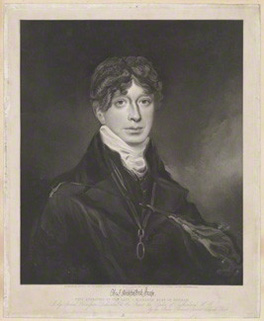Annotation:Miss Sharp’s Fancy: Difference between revisions
No edit summary |
No edit summary |
||
| Line 2: | Line 2: | ||
---- | ---- | ||
<p><font face="garamond, serif" size="4"> | <p><font face="garamond, serif" size="4"> | ||
'''MISS SHARPE'S FANCY'''. AKA – "[[Miss Sharpe's Favourite]]." Scottish (originally), Irish; Jig. D Major. Standard tuning (fiddle). AAB (Carlin, Gatherer): AABC (O'Neill). Composed by Charles Sharpe (1749–1813) of Haddam (sometimes 'Hoddom'), in honor of his daughter. Sharpe was the son of William Kirkpatrick of Ailsland, a younger brother of Sir Thomas Kirkpatrick, 3rd Baronet of Closeburn. On inheriting Hoddom Castle [http://en.wikipedia.org/wiki/Hoddam_Castle], Dumfriesshire, in the Borders, Charles changed his name to Sharpe, the name of his uncle’s line, from whom he inherited the estate. He set to work on the castle, repairing and improving it, and adding several rooms. Sharpe had a reputation as an excellent violinist, and also composed music and verse. He was a friend and correspondent of Robert Burns and Sir Walter Scott (See “[[Mr. Sharpe's Delight]]” for more). Miss Sharpe’s mother was Eleonora, daughter of John Renton of Lamberton, and a lady whose beauty is celebrated in Smollet’s '''Humphrey Clinker'''. See also McIntosh's "[[Miss Sharpe of Hoddom's Reel]]." | '''MISS SHARPE'S FANCY'''. AKA – "[[Miss Sharpe's Favourite]]." Scottish (originally), Irish; Jig. D Major. Standard tuning (fiddle). AAB (Carlin, Gatherer): AABC (O'Neill). Composed by Charles Sharpe (1749–1813) of Haddam (sometimes 'Hoddom'), in honor of his daughter. Sharpe was the son of William Kirkpatrick of Ailsland, a younger brother of Sir Thomas Kirkpatrick, 3rd Baronet of Closeburn. On inheriting Hoddom Castle [http://en.wikipedia.org/wiki/Hoddam_Castle], Dumfriesshire, in the Borders, Charles changed his name to Sharpe, the name of his uncle’s line, from whom he inherited the estate. He set to work on the castle, repairing and improving it, and adding several rooms. Sharpe had a reputation as an excellent violinist, and also composed music and verse. He was a friend and correspondent of Robert Burns and Sir Walter Scott (See “[[Mr. Sharpe's Delight]]” for more). Miss Sharpe’s mother was Eleonora, daughter of John Renton of Lamberton, and a lady whose beauty is celebrated in Tobias Smollet’s '''The Expedition of Humphrey Clinker''' (1769). See also McIntosh's "[[Miss Sharpe of Hoddom's Reel]]." | ||
<br> | <br> | ||
<br> | <br> | ||
Revision as of 11:16, 20 April 2017
Back to Miss Sharp’s Fancy
MISS SHARPE'S FANCY. AKA – "Miss Sharpe's Favourite." Scottish (originally), Irish; Jig. D Major. Standard tuning (fiddle). AAB (Carlin, Gatherer): AABC (O'Neill). Composed by Charles Sharpe (1749–1813) of Haddam (sometimes 'Hoddom'), in honor of his daughter. Sharpe was the son of William Kirkpatrick of Ailsland, a younger brother of Sir Thomas Kirkpatrick, 3rd Baronet of Closeburn. On inheriting Hoddom Castle [1], Dumfriesshire, in the Borders, Charles changed his name to Sharpe, the name of his uncle’s line, from whom he inherited the estate. He set to work on the castle, repairing and improving it, and adding several rooms. Sharpe had a reputation as an excellent violinist, and also composed music and verse. He was a friend and correspondent of Robert Burns and Sir Walter Scott (See “Mr. Sharpe's Delight” for more). Miss Sharpe’s mother was Eleonora, daughter of John Renton of Lamberton, and a lady whose beauty is celebrated in Tobias Smollet’s The Expedition of Humphrey Clinker (1769). See also McIntosh's "Miss Sharpe of Hoddom's Reel."

The Sharpe's had two children, the eldest being Charles Kirkpatrick Sharpe, a noted antiquarian and man of letters. The younger was Jane Kirkpatrick Sharpe (1773–1818), presumably the subject of this tune. She was born in 1773, and married her second cousin Sir Thomas Kirkpatrick (1777–1844), Baronet, sheriff of Dumfries-shire, in St. Andrews Church, Edinburgh, Scotland in 1804. They had seven children. She died at Capenoch, Thornhill, Dumfries, Scotland
Source for notated version:
Printed sources: Aird (Selection of Scotch, English, Irish and Foreign Airs, vol. 4), 1796; No. 109, p. 43. Carlin (The Gow Collection), 1986; No. 353. Gatherer (Gatherer's Musical Museum), 1987; p. 18. Gow (Third Collection of Neil Gow's Reels), 1792; p. 4 (3rd ed.). Manson (Hamilton's Universal Tune Book, vol. 2), 1846; p. 42. O'Neill (O'Neill's Irish Music), 1915; No. 194, p. 105.
Recorded sources:
